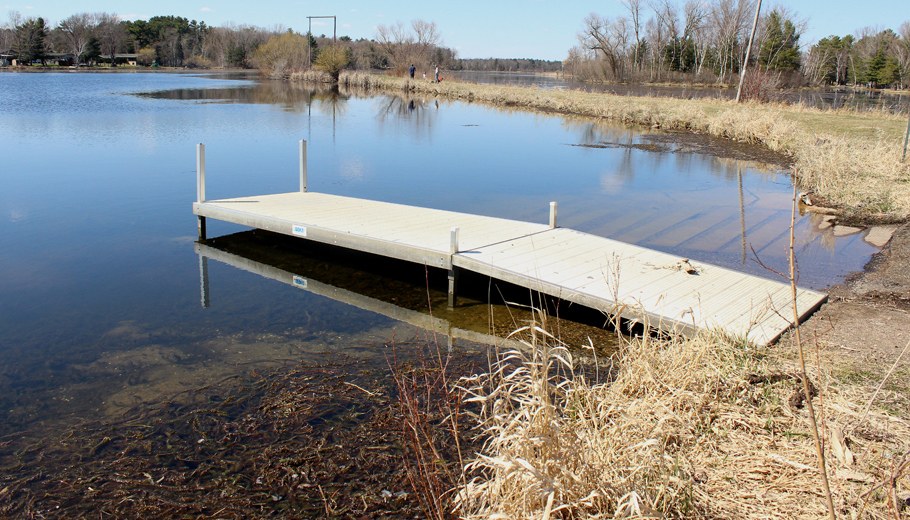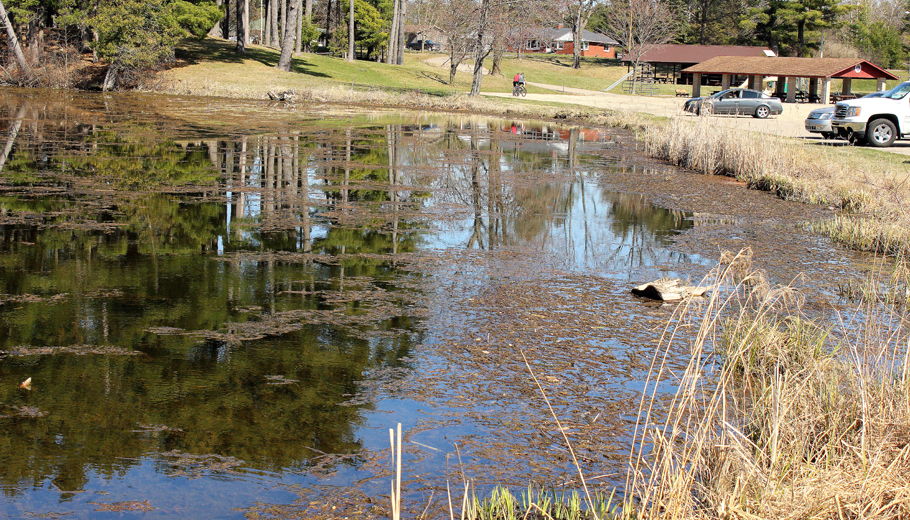Weed control expected to increase
By Greg Seubert
Weeds – lots of them – have been a problem for years on Lake Iola.
They might not be as big of a problem as in the past under the lake’s management plan.
The Lake Iola Lake Protection and Rehabilitation District hired Onterra LLC, a lake management planning company based in De Pere, to update the plan.
“In order to manage the lake, there are a couple of different permits that we have to have for harvesting (plants) and applying chemicals,” district chairman John Bertelson said. “Without an updated lake management plan, the chances of getting the permits approved are slim. The other reason we wanted to update our plan is because it opens up the opportunity for grants. Without an updated plan, you don’t get permits and you don’t get grants.”
Lake Iola is a 220-acre impoundment of the South Branch of the Little Wolf River. The dam creating the lake is located off North Main Street in Iola.
“It’s a nice fishing lake,” Bertelson said. “It has a great fishery, but it’s really hard to get to in the summer with all the weeds and algae. We had a drawdown from 2011 to 2013 because Eurasian milfoil was taking over. People on the lake didn’t like the drawdown because it pretty much destroyed our fishing for a couple of years and other weeds took over.”
The district has to obtain permits from the state Department of Natural Resources to harvest or chemical treat weeds in the lake.
“What the DNR wanted to do was a lake study before and after the drawdown,” Bertelson said. “Because of budget considerations, we couldn’t do the lake study and this plan until several years after because we depleted our funds. It would have been nice to do the study right after we brought the lake up, but we’re still able to tell the effect of the drawdown a few years later.”
Bertelson knows what he wants to see from the updated plan.
“My goal is to improve summertime navigation on the lake and to stay in charge until we get a program going that will hopefully give us better summertime use of the lake,” he said.
Bertelson, who owns property on the lake, has chaired the district the past six years and recently began a third three-year term.
“The plan is to work with the village,” he said. “The lake district is a volunteer organization and there’s always a chance that we could be voted out of business every year. We are considered a special unit of state government because we do tax for our funds. Unlike state government, everybody that’s in the district has a say as to whether we stay as a group.”
Harvesting program
The plan calls for the district to set up its own harvesting program instead of contracting with someone to do the work.
“I wanted to have the village’s cooperation,” Bertelson said. “We’re a group of volunteers and we don’t have the administrative staff like the village does. Plus, they have a public works department that should be able to help us with the maintenance. The idea is that anything that would cost the village would be charged to the lake district. We put a 10-year budget together that we voted on last year at the annual meeting to get this done.
“We had a resident on the lake, Cliff Schmidt, who had been our harvester operator on the lake and has harvested around the whole state for over 20 years,” he said. “We’re fortunate to have him on the lake. About the time we were doing our lake study, he decided to retire, but we talked him into staying on for one more year, which was last year. He stopped harvesting around the rest of the state and agreed to just do our lake last year and give us a chance to develop our plan. Timing-wise, it worked out good to develop our own harvesting plan.”
The DNR had recommended that the district come up with its own harvester program, according to Bertelson.
“Five or six years ago, the DNR was recommending that we really should consider our own harvester program like other lakes have around the state just because there are so many plants that need to be harvested all summer long,” he said. “Up until that time, we were buying 160 hours a summer of Cliff’s time. We used to do two 89-hour periods where he would start on the north end of the lake and harvest down to the south end and then he would move on to other lakes around the state. He would come back later in the summer and do another 80 hours.
“In the plan we put together now, we budgeted up to 400 hours at the same cost,” he said. “We were paying $20,000 a year for Cliff’s services and we’re now figuring $10,000 for operations, which allows us to put $18,000 a year away toward a new harvester or repairs. We tried to build that into all our current plan that we’re going to be starting this year. The village is going to own the equipment and the lake district’s going to lease and operate it. We’re still working out the details, but that’s the general plan. The harvesting permit starts June 1 and ends when the weeds stop growing in the fall. Our budget is now 400 hours a summer instead of 160 at the same cost.”
Taxes fund improvements
The district includes the village of Iola and the portion of the town of Iola that borders the lake.
“The district is the entire village of Iola, plus a few properties in the township that border the lake, essentially those properties on both sides of the road on Lake Shore Drive,” Bertelson said. “The reason they did that is it was hard to collect voluntary fees to manage the lake. At one time, they used to charge 60 (dollars) on-lake and 30 off-lake. That didn’t work well with the county system, so now it’s based on mill rate. The more expensive the property, the higher the tax is. I think my house on the lake is assessed at $125,000 and my taxes are $80 or $90 a year. It may be 40 or 50 (dollars) for off-lake.”
The district recently conducted a stakeholder survey.
“That was valuable to me to see what their opinion is,” Bertelson said. “There were people that didn’t see why they should be paying taxes for the rich property owners on the lake. Most people off the lake didn’t even return the survey, so I see that more as indifference.
“I did find a lot of interest in doing the management on the lake,” he added. “We have enough management goals in our new plan where there are opportunities for people that want to get involved to get involved. My main focus is to improve the summertime use on the lake. Once we do that, then the other things will follow along. If we can’t do it, then I don’t know if it’s worth it to actively manage the lake.”
Iola is fortunate to have a body of water in down, Bertelson said.
“I like the lake and I think people enjoy it at the park for the fireworks,” he said. “They just don’t like to see all those weeds in the summer.”
Weeds, weeds, weeds
Bertelson said fishing and boating activity on the lake drops after the weeds take hold.
“It goes way down,” he said. “Part of the study was to go around the entire lake and do a point intercept study. They had a grid system laid out on the lake with the different points that they measured. It was so bad that the people doing the measurements couldn’t get to all the spots on the lake. That tells you that it’s a problem.”
A permit to harvest weeds doesn’t mean the district can remove all of them, Bertelson said.
“We’re not allowed to harvest wherever we want on the lake,” he said. “The DNR, by permit, only allows us to harvest lanes. I think it’s around 35 acres that we’re allowed to harvest. We have to stay within those harvest lanes. We use a mixture of the harvester and in areas where we can’t harvest, we’re allowed to use chemicals with DNR inspection. It’s a combination of harvester and chemicals to keep those lanes clear.”
The district offered homeowners pier treatment last year to have chemicals applied around their pier out to the harvest lanes.
“The cost of that is borne by the homeowner,” Bertelson said. “The tax money takes care of the common-use areas of the lake. There’s a misconception out there that the tax money is going to the rich property owner. It’s not.
“Essentially, the taxes of the village are paying for the lake district,” he said. “Before the district, the village would take care of all of the lake issues. They didn’t want to deal with it 20-something years ago, so they created the lake district.”
The lake has a number of public access points. The main boat landing, with a pier and restrooms, is located in Olson Park off of County Trunk J. A smaller undeveloped landing popular in the winter is at the end of Priestly Way just off of Lake Shore Drive and a canoe and kayak access to the South Branch of the Little Wolf River north of the lake is located on Tresness Road.
Bertelson said he hopes the harvesting change ultimately results in fewer weeds for the lake.
“I hope so, but I’m not sure until we actually start doing it because it’s a new program for us,” he said. “It allows us to harvest when and where it’s needed. When we were hiring to get it done, it would always have to start on the north end of the lake and work to the south end. By then, the 40 hours were up and there was not much time to go back and catch any areas where plants had drifted into. This will allow us to catch the bad areas all summer long.
“If you can’t improve the lake use in the summertime, then the rest of the management activities I don’t think are that important,” he said. “That’s what people have been calling for for a long time on that lake: improve the summertime use. That’s my overall goal here.”


